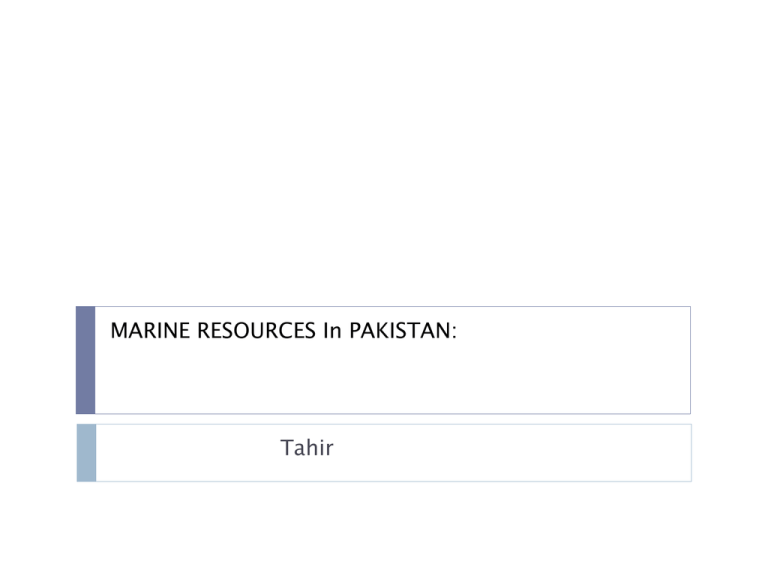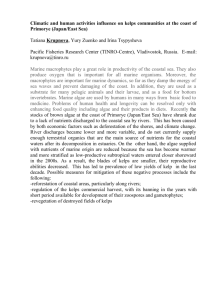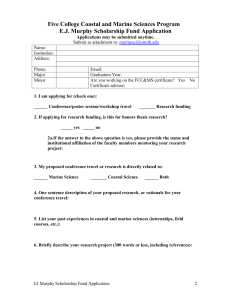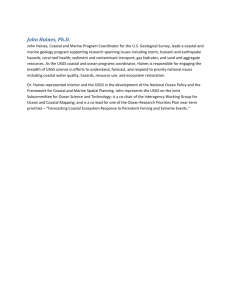MBT lec 4 - Lectures For UG-5
advertisement

MARINE RESOURCES In PAKISTAN: Tahir Marine Resources Resources are being continuously removed from the earth due to high growth rates of human population. Many of these resources are non-renewable such as fossil fuels, minerals etc. and may be close to exhaustion due to unsustainable exploitation. Non-renewable energy sources are also declining. In recent years emphasis has been laid on identifying renewable resources. In Pakistan the Sindh coastal zone has great potential of both living and non-living resources. Most of these are largely under-exploited and to some extent unexplored. Ocean resources in the economic and social context The Pakistan coast is about 1000 km long extending from the Indian border on the east to the Iranian border in the west. The Exclusive Economic Zone (EEZ) of Pakistan is about 240,000 sq. km with an additional continental shelf area of about 50,000 sq. km. As such, the total maritime zone of Pakistan is over 30% of the land area A total of 370 kilometers (km) of coastline extends along the province of Sindh between the Indian border along Sir Creek on the east to Hub River coast on the west. Mangrove forests are a major feature of the Sindh coast. The area under mangroves in Sindh is the sixth largest in the world (Mirza et al 1983). A combination of the subtropical environment and the riverine flow into the Indus delta has resulted in a highly productive coastal zone of significant biodiversity and economic value. These deltaic networks of creeks are a major breeding area for commercially important coastal fisheries including shrimps and crabs with a potential resource equivalent to US$68 million a year (2001 price) (Raza & Khan 2002). About half of the fish exported from Pakistan is netted on the Sindh coast. The Pakistan coastal area is not only rich in living resources but it is also characterized by distinctive oceanic phenomena that could produce abundant mineral, renewable energy and hydrocarbon resource. According to a preliminary survey conducted by the National Institute of Oceanography, it is estimated that about 1100 MW power can be produced from the Indus Deltaic Creek areas (Qurashee 1986). Recent estimates indicate that out of the total marine resource production for Pakistan, 71% is derived from Sindh (Raza & Khan 2002). However, coastal communities are one of the poorest communities in Pakistan and their livelihood resources are under constant threat of depletion. About 90% of the households in the coastal communities rely on fishing and other fisheries related activities (Siddiqi 2007) Living resources: Vegetation Coastal seaweeds are available in great abundance reaching a value as high as 112 ton/hectare along the coast (UNESCAP 1996). There are eight species of mangroves along the coast, Avicennia marina is the most dominant mangrove forest (Saifullah, 1997). The nutrient rich coastal waters support masses of phytoplankton including diatoms, dinoflagellates, and other algae that grow especially in areas where mangrove forests contribute nutrient-rich waters to the marine ecosystem. Phytoplankton provides a rich source of food for marine animals. Animal Life The coastal/marine areas of Pakistan support large fisheries. Fishing grounds for large pelagics species, tuna, mackerel, sharks etc. are located in our offshore waters. Species such as mullet, silver wittings and other small sized fishes, especially juveniles of large commercially important estuarine fish, are harvested from shallow waters in the creek area of the Indus and other small rivers and also in enclosed and semi-enclosed bays throughout the coastal waters (UN-ESCAP 1996) It is estimated that 1 hacter of mangrove if properly managed could produce an annual yield of: 25 kg shrimp, 100 kg fish, 15 kg crab meat, 200 kg mollusc, and 40 kg sea cucumber. In addition to these mangrove forests provide indirect support for 400 kg of fish and 75 kg of shrimp that mature in off-shore areas. Pakistan has over 230,000 hac. of mangrove area (Hinrichsen 1990). Non-Living Resources: Fresh Water A huge quantity of fresh water resource is available in the form of seawater. This resource can be utilized economically with the development of desalination technology (Khan 1999). It will become increasingly essential to develop this resource as the cost of sweet water increases and Pakistan becomes a water shortage facing country Energy Renewable Ocean Energy: Tides, Currents, and Waves Coastal marine areas have significant potential for energy/ fuel generation from marine plants and other organic materials, hydrocarbons can be generated from a variety of ocean renewables and marine geothermal power ((Quraishee 1986 & Zaigham 2004). There are also opportunities for hybrid projects, such as a combination of offshore wind and wave or wind and natural gas. Wave Energy Converter systems extract the power of ocean waves and convert it into electricity. Typically, these systems use either a water column or some type of surface or just-below-surface buoy to capture wave power. Tidal/Current systems capture the energy of ocean currents below the wave surface and convert them into electricity. Typically, these systems rely on underwater turbines, either horizontal or vertical, which rotate due to either change in the ocean current or changing tide (either one way or bi-directionally), almost like an underwater windmill. Ocean Thermal Energy Conversion (OTEC) generates electricity through the temperature differential in warmer surface water and colder deep water. Offshore Wind generates electricity by taking advantage of the vast wind resources available across oceans and large water bodies. Out at sea, winds blow freely, unobstructed by buildings or other structures. Moreover, winds over oceans are stronger than most onshore winds, thus allowing for wind projects with capacity factors of as high as 65 percent, in contrast to the 35-40 percent achieved onshore Bio-fuel (next-generation fuel Marine microalgae, a simple rootless plant accumulates high levels of natural oils and has promising potential as an alternative energy source, it is expected to yield significant energy security and environmental advantage (Teresa 2010). There are abundance growths of various algae along the coastal area of Pakistan which could be a source of renewable energy in general, and biofuel in particular. Advantages of deriving biodiesel from algae include their rapid growth rate, a high per-acre yield. Moreover, algae biofuel contains no sulfur, or-toxic material and is highly biodegradable. Oil and Gas Offshore regions of Pakistan have thick marine sedimentary reservoir rocks with potential traps both structural and stratigraphic. These are a positive indication of the occurrence of hydrocarbon resources in the offshore regions. Based on per cubic mile yield of analogue producing basins offshore potential 16,650 million barrels of oil or equivalent gas have been estimated (Quadri 1984). All the prerequisites of oil and gas occurrence i.e. source, reservoir and traps are amply present in the offshore basins of Pakistan. Many seismically delineated anticlinal traps are available for exploration Deltas, their fans and cones are favorable locations for oil and gas accumulation. They contain buried structures and channels under the huge thickness of sediments. The Indus delta and Indus offshore areas have proved to be a major hydrocarbon producing area. In the deltaic region, exploration activities have identified many promising fields. A large number of untested have been seismically delineated in the Balochistan offshore area. Surface features such as oil seepages and mud volcanoes show the generation of hydrocarbons in the area. Gas deposits (mostly methane) are common along the Makran coast (Harms 1984). Offshore Makran has shown good quality reservoir rock. From the Makran continental margin gas hydrates can be extracted as another source of energy that has been discovered recently. Increase in the sea level and the adverse impact of coastal flooding and storm surge activity due to climate change can cause damage to the coastal oil and gas infrastructure. Industrial chemicals Marine flora and fauna and seawater have always been sources of chemicals for industries that include leather, paper, textile, cosmetics, food, and pharmaceuticals. A variety of marine organisms along the Pakistan coast are potential sources of pharmaceutical compounds such as antibiotics, CNS drugs and muscular drugs, anticancer and antitumor, antiviral and cardioactive drugs (Khan & Nisa 2002). Mineral Potential Continental margin and sea floor of the northern Arabian Sea possesses all the important geological features which create bright prospects for non living resources. The coastal areas and continental margin of the Arabian Sea contain a wide variety of mineral deposits of zirconium, rutile and ilmenite. Deltaic environments are especially favorable for oil, gas, coal and heavy mineral deposits (Husain & Bilqees, 1994). During the past few years exploration work has intensified. Future exploitation of these minerals along the coast of Pakistan are envisaged. Building Material The reserves of gravel and sand in the coastal area drained by the rivers have been heavily exploited during the past decades for construction purposes. In coastal areas, deposits of shells and calcareous sand have been in use for construction and making lime. In shallow waters, the mechanical action of waves and currents concentrates sand and gravel. Offshore sediments in Pakistan’s territorial waters are found to be rich in calcareous material composed of recent shells, and in future it may be mined for industrial use. Coarse calcareous sand is a common material found along the Makran continental shelf. Along the Makran coast, at the mouth of seasonal rivers, gravel and pebbles are found in abundance Sea Salts Presently sea salt of about 60,000m tons/year is being extracted from the seawater along the Sindh and Balochsitan coasts. Soda ash and other salts are also being extracted on a small scale by the traditional methodology of creating saltpans in enclosed water. Saltpans are successful in regions with dry hot climates where salt is formed by evaporation of sea water through the action of solar energy. Extensive patches of such salt deposits occur in the area south of Jatti. Salt is being extracted from sea water near Karachi. Frequent storm surge and flood harms the salt industry Coastal resource management issues The assessment and exploration of these resources is vital for the economy of the country but it requires heavy investment. At present, we do not even know the full potential of our coastal marine resources, because these resources have not been fully identified/quantified Constraints on marine resources management are as follows: Lack of coordination among stakeholders Uncontrolled exploration of marine resources leading to environmental hazards and/or use conflicts Lack of political commitment and low harmonization of management plans and legislation related to marine resources Natural disasters such as rising sea level, flooding, forest fires etc. national The following RECOMMENDATIONS are made to expedite resource development of the Pakistan coastal area • Promote education and research in marine science and technology. • Development, management and sustainable utilization of all coasta marine resources. education, research and technology development • More funding for ocean/marine • Substantial ocean resources should be mapped and studied. • Incentives should be provided for private investments fo promotion of ocean technologies. • Economic management of coastal marine areas and sustainable use of marine resources • Improved institutional capacity and effectiveness in coastal marine resources management along the coast. PAKISTAN BUSINESS REVIEW JANUARY 2011 Nuzhat Khan; National Institute of Oceanography, Karachi








